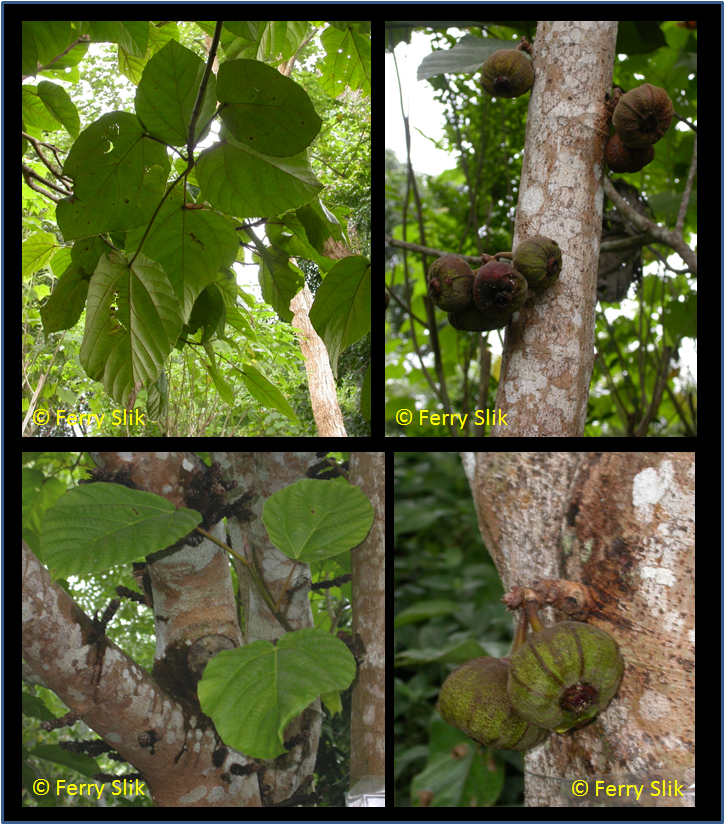Ficus auriculata Lour., Fl. Cochinch. 666 (1790)
Latin for 'with ears', referring to the leaf shape.Synonyms
Covellia macrophylla Miq.
Ficus hainanensis Merr. & Chun
Ficus hamiltoniana Wall. [Invalid]
Ficus macrocarpa H.L¨¦v. & Vaniot [Illegitimate]
Ficus macrophylla Roxb. & Buch.-Ham. ex Sm. [Illegitimate]
Ficus oligodon Miq.
Ficus pomifera Wall. ex King
Ficus regia Miq.
Ficus rotundifolia Roxb.
Ficus roxburghii Steud.
Ficus sclerocarpa Griff.
Ficus scleroptera Griff. [Illegitimate]
Diagnostics
A small spreading tree, up to 12 m tall. Leaves very large, ovate, up to 55 cm x 30 cm. Fruit a
fig, in short ropes from the branches to the base of the trunk, depressed pear-shaped, 5-9 cm wide,
reddish-brown, fragrant; flesh red-purple.
Description
Trees, 4-12 m tall, crown elongated and wide, d.b.h. 10-15 cm; dioecious. Bark grayish brown, rough. Branchlets reddish brown, 1-1.5 cm thick,
leafless in middle of stem, pubescent. Stipules reddish purple, triangular-ovate, 1.5-2 cm, adaxially shortly pubescent. Leaves alternate;
petiole thick, 5-8 cm; leaf blade broadly ovate-cordate, 15-55 by (10-)15-30 cm, thickly papery, abaxially with short spreading pubescence,
adaxially glabrous or puberulent on midvein or secondary veins, base cordate to occasionally rounded, margin regularly shallowly dentate,
apex obtuse and mucronate; basal lateral veins 4-6, secondary veins 3 or 4 on each side of midvein, abaxially prominent, and adaxially slightly
impressed or flat. Figs on specialized leafless branchlets at base of trunk and main branches, reddish brown, pear-shaped, depressed globose,
or top-shaped, with 8-12 conspicuous longitudinal ridges, 3-5(-6) cm in diam., white, shortly pubescent when young, glabrescent when mature;
peduncle (2-)4-6 cm, thick, pubescent; involucral bracts triangular-ovate; apical bracts in 4 or 5 rows, broadly triangular-ovate, imbricate,
rosulate. Male flowers: sessile; calyx lobes 3, transparent, spatulate, thinly membranous; stamens 2; filaments long; anthers ovoid. Gall flowers:
calyx lobes 3, apically free, ¡À covering ovary; style lateral, hairy; stigma enlarged. Female flowers: pedicellate or sessile; calyx lobes 3;
ovary ovoid; style lateral, longer than in gall flowers, with hairs. Achenes with adherent liquid. Fl. Aug-Mar, fr. May-Aug.
Ecology
Forests in moist valleys; 100-1700(-2100) m.
Distribution
Nepal and India to Southern China, Hainan and Indochina.
Uses
The large figs are edible and are used in the preparation of jam, juice and curries. In Vietnam
unripe fruits are used in salads. In India the leaves are used as fodder and the trees are planted
as host trees for lac insects. In Xishuangbanna the young leaves are boiled and eaten with spicy
sauce.
Local names
Burma: sin-thahpan.
China: Da guo rong.
Malaysia: ara, kelebok, mangtan.
Thailand: duea-wa (Chiang Mai), saipho (central).
Vietnam: va'.
